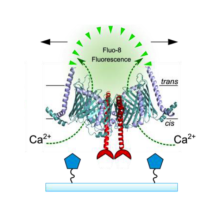Single-molecule studies can reveal phenomena that remain hidden in ensemble measurements. Here we show the correlation between lateral protein diffusion and channel activity of the general protein import pore of mitochondria (TOM-CC) in membranes resting on ultrathin hydrogel films. Using electrode-free optical recordings of ion flux, we find that TOM-CC switches reversibly between three states of ion permeability associated with protein diffusion. While freely diffusing TOM-CC molecules are predominantly in a high permeability state, non-mobile molecules are mostly in an intermediate or low permeability state. We explain this behavior by the mechanical binding of the two protruding Tom22 subunits to the hydrogel and a concomitant combinatorial opening and closing of the two β- barrel pores of TOM-CC. TOM-CC could thus be the first β-barrel membrane protein complex to exhibit membrane state-dependent mechanosensitive properties, mediated by its two Tom22 subunits.
For reference, see Spatiotemporal stop-and-go dynamics of the mitochondrial TOM core complex correlates with three-state channel activity Wang, S., Findeisen, L., Leptihn, S., Wallace, M.I., Hörning, M. & Nussberger, S. Communications Biology 5, 1-11 Article number: 471 (2022)
-
MovieS1WangetalCB.mov
Imaging the channel activity of single TOM-CC molecules
-
MovieS2WangetalCB.mov
Time evolution of TOM-CC channel activity
-
MovieS3WangetalCB.mov
Correlation between stop-and-go dynamics and open-closed channel activity of single TOM-CC molecules
-
MovieS4WangetalCB.mov
Stop-and-go movement of fluorescently labeled TOM-CC
-
MovieS5WangetalCB.mov
Lateral movement and channel activity of single Tom40 molecules
-
MovieS6WangetalCB.mov
Lateral movement and channel activity of single OmpF molecules
-
MovieS7WangetalCB.mov
Single channel activity of transiently and permanently trapped TOM-CC molecules


